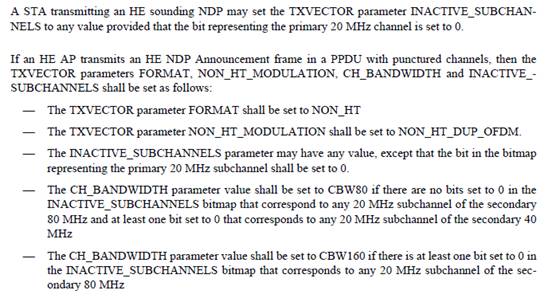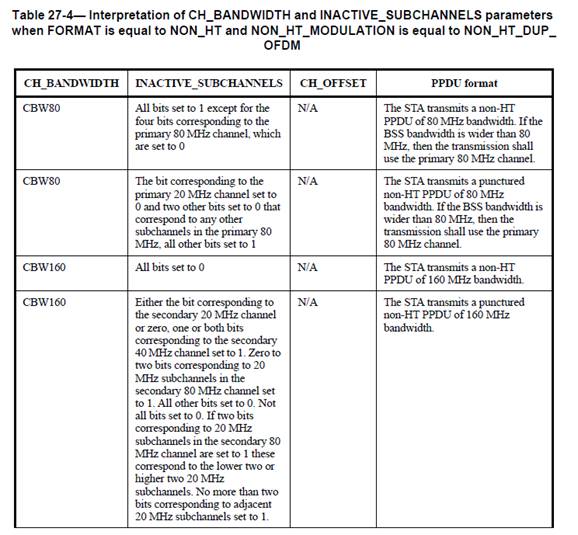Hi Youhan and all,
Please find the DCN157r3 for “PDT for Effect of CH_BANDWIDTH parameter on PPDU format”
To Youhan,
Most suggestion is accepted and some subclause as references are added to make it clear. One comment is as below.
For CBW320, if INACTIVE_SUNCHANNELS is not present, it should be a non-punctured non-HT PPDU of 320 MHz bandwidth.
- Deleting “punctured” and adding “using sixteen adjacent 20 MHz channels ….”

If there are additional comments, please let me know.
Regards,
Yujin
From: Youhan Kim
youhank@xxxxxxxxxxxxxxxx
Sent: Tuesday, April 13, 2021 4:13 PM
To: Yujin Noh <Yujin.Noh@xxxxxxxxxxxx>; STDS-802-11-TGBE@xxxxxxxxxxxxxxxxx
Subject: RE: [STDS-802-11-TGBE] PDT for Effect of CH_BANDWIDTH parameter on PPDU format
**BE CAUTIOUS**
THIS EMAIL ORIGINATED FROM OUTSIDE SENSCOMM. DO
NOT CLICK ANY LINKS OR OPEN ATTACHMENTS UNLESS YOU RECONGNIZE THE SENDER AND KNOW THE CONTENTS ARE SAFE. ALSO BE CAUTIOUS WHEN ‘REPLYING TO ALL’.
Thanks, Yujin.
That discrepancy between 26.11.7 and 27.2.5 is a good example why we should avoid duplicating information – and get it wrong.
I think what you tried to convey as “non-OFDMA” and “OFDMA” is how the puncturing patterns for non-HT duplicate may be affected depending on what kind of packet sequence the non-HT duplicate PPDU is part of. PHY is oblivious to the packet
exchange sequence. Also, INACTIVE_SUBCHANNELS is a TXVECTOR which is set by MAC. So, I think it is best to leave any instructions on how to set the INACTIVE_SUBCHANNELS to clause 35. Clause 36 simply needs to understand how to transmit it.
Regards,
Youhan
From: Yujin Noh <Yujin.Noh@xxxxxxxxxxxx>
Sent: Monday, April 12, 2021 9:17 PM
To: Youhan Kim <youhank@xxxxxxxxxxxxxxxx>;
STDS-802-11-TGBE@xxxxxxxxxxxxxxxxx
Subject: RE: [STDS-802-11-TGBE] PDT for Effect of CH_BANDWIDTH parameter on PPDU format
CAUTION: This email originated from outside of
the organization.
Hi Youhan,
Thank you for the suggestion.
Reviewing your modification, I think I can get your points.
However, there are some clarification questions.
- Given this modification, where we can define what to indicate in INACTIVE SUBCHANNEL parameter?
- 11ax, there are two places with 1) 26.11.7 INACTIVE_SUBCHANNELS and RU_ALLOCATION and 2) 27.2.5 Effects of CH_BANDWIDTH parameter on PPDU format.
- This is the PHY part what I drafted on INACTIVE_SUBCHANNELS parameter which borrowed from the puncturing patterns defined in U-SIG like BW field of HE-SIG-A in 11ax.
- Non-OFDMA and OFDMA is just used to refer the tables. If the issue is the terms, I can delete them and use “either … or …” and leave the rest part as it is.
- Or do you want to leave it as TBD for further discussion by removing the column of INACTIVE_SUBCHANNELS parameter?
- By the way, I just found out that different setting between two places.
- In 26.11.7,

- In 27.2.5,

If I missed something, please let me know.
Regards,
Yujin
From: Youhan Kim
youhank@xxxxxxxxxxxxxxxx
Sent: Monday, April 12, 2021 3:18 PM
To: Yujin Noh <Yujin.Noh@xxxxxxxxxxxx>;
STDS-802-11-TGBE@xxxxxxxxxxxxxxxxx
Subject: RE: [STDS-802-11-TGBE] PDT for Effect of CH_BANDWIDTH parameter on PPDU format
**BE CAUTIOUS**
THIS EMAIL ORIGINATED FROM OUTSIDE SENSCOMM. DO
NOT CLICK ANY LINKS OR OPEN ATTACHMENTS UNLESS YOU RECONGNIZE THE SENDER AND KNOW THE CONTENTS ARE SAFE. ALSO BE CAUTIOUS WHEN ‘REPLYING TO ALL’.
Hi, Yujin.
Thank you for
https://mentor.ieee.org/802.11/dcn/21/11-21-0157-02-00be-pdt-effect-of-ch-bandwidth-parameter-on-ppdu-format.docx.
While I understand the document has passed SP last week, I find the portions related to non-HT duplicate transmission difficult to understand.
For example, Table 36-x2 is purely about transmitting non-HT duplicate PPDUs, but it talks about “non-OFDMA” and “OFDMA” cases. But non-HT duplicate PPDUs have no concept of non-OFDMA and OFDMA.
I suggest to
- Delete Table 36-x2 and relevant texts
- Put non-HT duplicate related information in Table 36-x1
Attached document is one such implementation.
Thanks.
Youhan
From: Yujin Noh <Yujin.Noh@xxxxxxxxxxxx>
Sent: Tuesday, April 6, 2021 6:33 PM
To: STDS-802-11-TGBE@xxxxxxxxxxxxxxxxx
Subject: Re: [STDS-802-11-TGBE] PDT for Effect of CH_BANDWIDTH parameter on PPDU format
CAUTION: This email originated from outside of
the organization.
Hi Lei,
Thank you for your comment.
In the uploaded version on the server, it’s been fixed as below.
I hope it could be able to reflect your intention (nonpunctured or punctured) as well.

Regards,
Yujin
From: HUANG LEI
huang.lei1@xxxxxxxx
Sent: Tuesday, April 6, 2021 6:27 PM
To: Yujin Noh <Yujin.Noh@xxxxxxxxxxxx>;
STDS-802-11-TGBE@xxxxxxxxxxxxxxxxx
Subject: RE: [STDS-802-11-TGBE] PDT for Effect of CH_BANDWIDTH parameter on PPDU format
**BE CAUTIOUS**
THIS EMAIL ORIGINATED FROM OUTSIDE SENSCOMM. DO
NOT CLICK ANY LINKS OR OPEN ATTACHMENTS UNLESS YOU RECONGNIZE THE SENDER AND KNOW THE CONTENTS ARE SAFE. ALSO BE CAUTIOUS WHEN ‘REPLYING TO ALL’.
Hi Yujin,
Thanks. Attached please find my comments.
Best regards,
Lei
From: Yujin Noh <Yujin.Noh@xxxxxxxxxxxx>
Sent: Wednesday, April 7, 2021 2:47 AM
To: STDS-802-11-TGBE@xxxxxxxxxxxxxxxxx
Subject: Re: [STDS-802-11-TGBE] PDT for Effect of CH_BANDWIDTH parameter on PPDU format
Hi Alice and all,
Please find the updated version.
- Added B3-B6 of U-SIG2 to make it clear for the OFDMA case.
- remove nonpuctured cases for CBW80/160/320 from the table.
If you have comments or concerns, please let me know.
Regards,
Yujin
From: Yujin Noh <Yujin.Noh@xxxxxxxxxxxx>
Sent: Monday, April 5, 2021 2:36 PM
To: STDS-802-11-TGBE@xxxxxxxxxxxxxxxxx
Subject: Re: [STDS-802-11-TGBE] PDT for Effect of CH_BANDWIDTH parameter on PPDU format
**BE CAUTIOUS**
THIS EMAIL ORIGINATED FROM OUTSIDE SENSCOMM. DO
NOT CLICK ANY LINKS OR OPEN ATTACHMENTS UNLESS YOU RECONGNIZE THE SENDER AND KNOW THE CONTENTS ARE SAFE. ALSO BE CAUTIOUS WHEN ‘REPLYING TO ALL’.
Hi Alice,
That’s a good point.
I will update it based on your two comments.
Regards,
Yujin
From: Alice Jialing Li <jialing.li.phd2@xxxxxxxxx>
Sent: Monday, April 5, 2021 2:32 PM
To: Yujin Noh <Yujin.Noh@xxxxxxxxxxxx>
Cc: TGBE <STDS-802-11-TGBE@xxxxxxxxxxxxxxxxx>
Subject: Re: [STDS-802-11-TGBE] PDT for Effect of CH_BANDWIDTH parameter on PPDU format
**BE CAUTIOUS**
THIS EMAIL ORIGINATED FROM OUTSIDE SENSCOMM. DO
NOT CLICK ANY LINKS OR OPEN ATTACHMENTS UNLESS YOU RECONGNIZE THE SENDER AND KNOW THE CONTENTS ARE SAFE. ALSO BE CAUTIOUS WHEN ‘REPLYING TO ALL’.
Hi Yujin,
Two comments to Table 36-x2 in the PDT:
1. For the OFDMA case, do you need to refer to the 4-bit bitmap (B3-B6 of U-SIG-1) to be more specific?
2. Is there a need to split each CBW into the nonpunctured case and punctured case? Note that the non-OFDMA case includes the nonpunctured pattern. In the next spec draft which will incorporate resolved CIDs in the U-SIG subclause, the
pattern '1111' would be added to the OFDMA case as well. So, the nonpunctured case is just a special case to the general _expression_ of the punctured pattern.
Best regards,
Alice Chen
Qualcomm
On Mon, Apr 5, 2021 at 12:40 PM Yujin Noh <Yujin.Noh@xxxxxxxxxxxx> wrote:
Hi all,
Attached please find the PDT for Effect of CH_BANDWIDTH parameter on PPDU format.
Based on the discussion last teleconference call, all the puncturing patterns for both non-OFDMA and OFDMA are included in INACTIVE_SUBCHANNELS parameter.
With this PDT to be approved, then one CID linked to this document would be ready.
Let me know if you have any comments and questions.
Regards,
Yujin
To unsubscribe from the STDS-802-11-TGBE list, click the following link: https://listserv.ieee.org/cgi-bin/wa?SUBED1=STDS-802-11-TGBE&A=1
To unsubscribe from the STDS-802-11-TGBE list, click the following link:
https://listserv.ieee.org/cgi-bin/wa?SUBED1=STDS-802-11-TGBE&A=1
To unsubscribe from the STDS-802-11-TGBE list, click the following link:
https://listserv.ieee.org/cgi-bin/wa?SUBED1=STDS-802-11-TGBE&A=1
OPPO
本电子邮件及其附件含有OPPO公司的保密信息,仅限于邮件指明的收件人使用(包含个人及群组)。禁止任何人在未经授权的情况下以任何形式使用。如果您错收了本邮件,请立即以电子邮件通知发件人并删除本邮件及其附件。
This e-mail and its attachments contain confidential information from OPPO, which is intended only for the person or entity whose address is listed above. Any
use of the information contained herein in any way (including, but not limited to, total or partial disclosure, reproduction, or dissemination) by persons other than the intended recipient(s) is prohibited. If you receive this e-mail in error, please notify
the sender by phone or email immediately and delete it!
To unsubscribe from the STDS-802-11-TGBE list, click the following link:
https://listserv.ieee.org/cgi-bin/wa?SUBED1=STDS-802-11-TGBE&A=1
To unsubscribe from the STDS-802-11-TGBE list, click the following link: https://listserv.ieee.org/cgi-bin/wa?SUBED1=STDS-802-11-TGBE&A=1